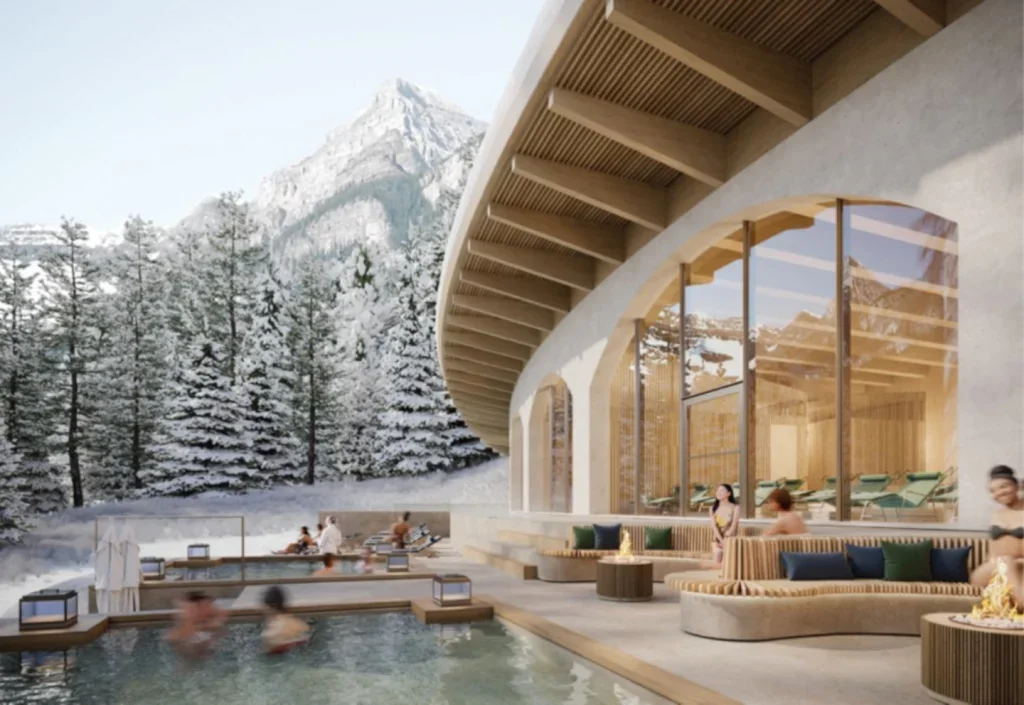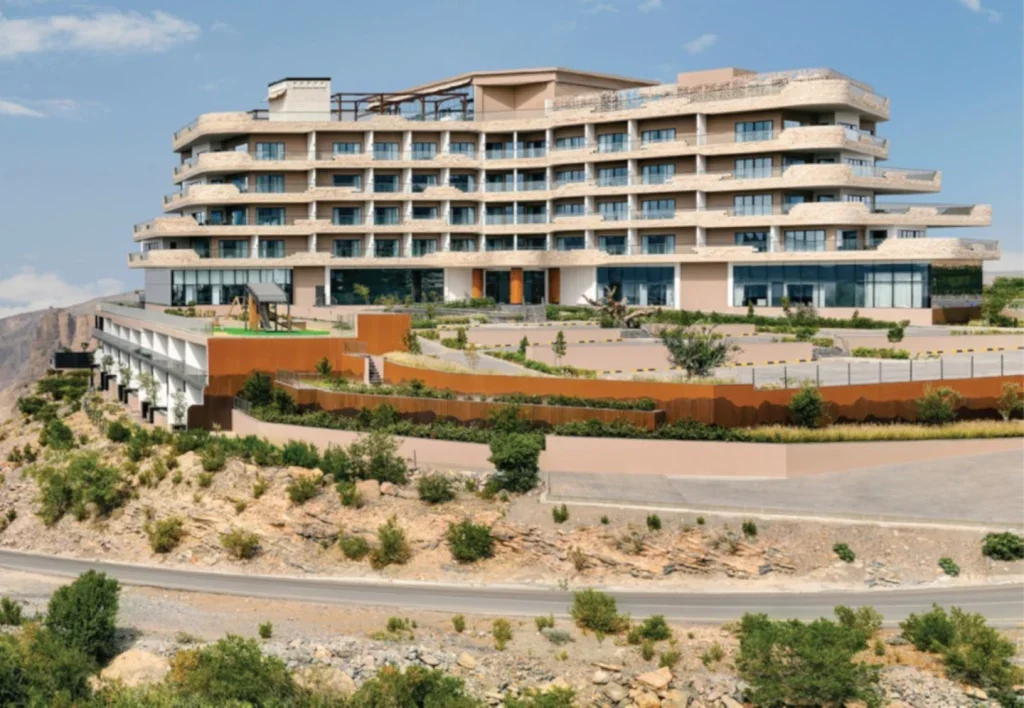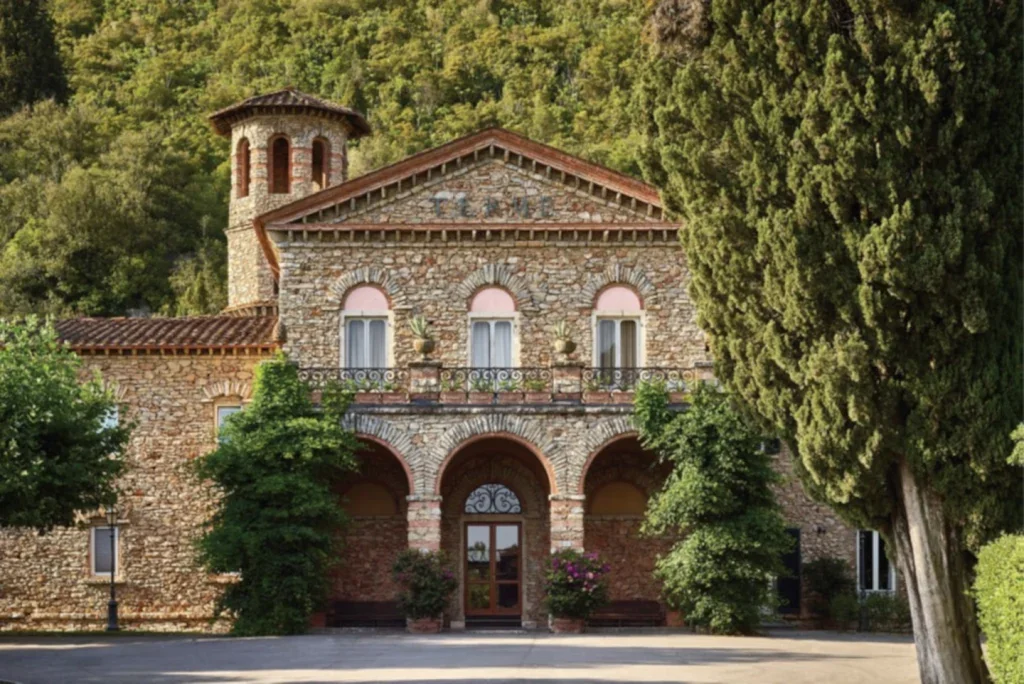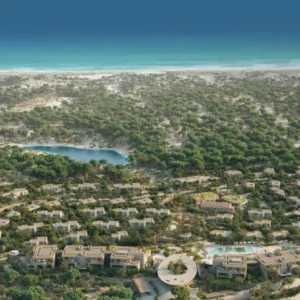
From the Canadian Rockies to the mountains of Oman, thermal bathing is emerging as a defining feature of the modern luxury resort. One anticipated opening in the former as part of the hotel wellness space is BASIN Glacial Waters at Fairmont Chateau Lake Louise, part of the Accor portfolio. Slated to open in the summer of 2025, this indoor-outdoor thermal experience is seeking to push the boundaries of spa luxury. “BASIN sets a new worldwide standard for thermal spa luxury and will be a flagship for Fairmont’s new well-being platform,” championed Emlyn Brown, senior vice-president, well-being, strategy, design & development at Accor, in a release.
Nestled within the awe-inspiring Canadian Rockies, Accor’s BASIN Glacial Waters is looking to offer guests a multisensory, self-guided journey of reflection, renewal and vitality. Designed by renowned architect Matteo Thun, the space features an infinity pool that extends onto an outdoor deck, reflexology and waterfall feature pools. “Introducing this impressive facility at Fairmont Chateau Lake Louise is an invite for guests to take their interpretation of well-being discovery to an entirely different level,” added Tracy Lowe, general manager of the property.
Also touted in the long read of features is an array of thermal bathing options, including Finnish and Bio saunas, steam rooms and contrast therapy pools.
Beyond its luxury appeal, BASIN seems to be signalling a broader shift within Accor’s wellness strategy. The integration of hydrotherapy, natural elements and high-end service aligns with the company’s vision of redefining hotel wellness, positioning thermal experiences as a cornerstone of its evolving hospitality model.

But what is thermal wellness really? Iceland’s Blue Lagoon can’t be the only player in town. Well, the practise refers to the use of heat and water therapies for relaxation, rejuvenation and overall well-being. It might involve hydrotherapy treatments such as thermal baths, saunas, steam rooms, contrast therapy (hot and cold immersion), mineral-rich waters and other heatbased experiences. These practices have roots in ancient traditions – from Roman baths to Nordic saunas and Japanese onsens – and are now being reimagined in luxury hotel spas worldwide. The focus is on harnessing natural elements like geothermal springs, glacial waters and Himalayan salt to enhance physical and mental wellness. Something BASIN Glacial Waters is trying to tap into with its varying-temperature pools, for example, but is the real goal to literally tap into the local geothermal activity?

83%
The percentage of 400 sauna users that experienced improved sleep quality, revealed in a recent global survey.
McKinsey’s 2024 Wellness Market Report
Europe’s thermal heritage reimagined
Across the Atlantic, thermal bathing has deep roots in European culture, and hotel groups are reviving and modernising these traditions. Marriott, in particular, has been investing in properties that fuse historic charm with cutting-edge wellness. A prime example is the recently renovated Grotta Giusti Thermal Spa Resort in beautiful Tuscany. Following a two-year refurbishment, this 19th-century retreat – once home to Italian poet Giuseppe Giusti – has enhanced its spa offerings while preserving its cultural heritage. And the big sell? At the heart of Grotta Giusti’s wellness experience is its 130-million-year-old thermal cave, the largest of its kind in Europe. Here, guests are invited to journey through a unique underground circuit inspired by Dante’s Divine Comedy, moving through Paradiso (heaven), Purgatorio (purgatory) and Inferno (hell), each with varying temperatures and humidity levels.
Elsewhere, the Meditarium, a new thermal and wet area, expands the experience further with Roman baths, steam baths, saunas infused with essential oils and ice showers. “This transformation solidifies Grotta Giusti’s place as a premier destination for those seeking a profound and natural wellness experience,” the resort boasts. Now part of Marriott’s Autograph Collection, Grotta Giusti exemplifies the brand’s strategy of integrating historic spa destinations into its wellnessdriven portfolio. The resort’s newly added experience showers, an ice waterfall and hydrotherapy pools perhaps position it among the most luxurious thermal spa retreats in Europe. Marriott’s investment in wellness tourism is a good indication of where the industry is heading – towards experiences that prioritise both cultural authenticity and innovative relaxation techniques.
Middle Eastern promise
The Middle East is also embracing the trend, with IHG leading the charge through its Hotel Indigo brand. The Hotel Indigo Jabal Akhdar Resort & Spa in Oman has unveiled Jala Spa & Wellness, the largest wellness centre in the region. Set amidst the landscapes of Jabal Akhdar, the spa takes inspiration from those allimportant natural elements, incorporating Himalayan salt rooms, extensive thermal zones and vitality pools.
“Our team has poured their heart and soul into creating a place that captures the very essence of Jabal Akhdar,” said James Reeves, general manager of Hotel Indigo Jabal Akhdar. This expansive spa experience aims to extend beyond treatments, promoting a holistic connection with the region’s culture and natural surroundings. The spa, part of IHG’s commitment to evolving wellness within its luxury portfolio, is expected to set a precedent for future developments across the group’s properties. IHG’s, as well as Accor’s and Marriot’s, increasing focus on wellness-centric properties reflects a shift in consumer preferences. Jala Spa’s emphasis on traditional Omani practices, combined with advanced wellness technology, highlights IHG’s approach to crafting bespoke well-being spaces that align with the natural beauty of their destinations and a growing consumer demand for authentic experiences. The brand’s investment in these thermal wellness experiences also signals its ambition to compete with the industry’s biggest players in the luxury wellness sector.
The growing appeal of thermal experiences
Apart from seeking those Instagramable, authentic experiences, what other factors are driving this surge in thermal wellness? One element is the increasing awareness of hydrotherapy’s health benefits. Studies suggest that alternating between hot and cold-water immersion can improve circulation, reduce stress, aid muscle recovery and enhance overall well-being. With wellness tourism continuing to expand, hotels are responding by designing spa experiences that offer guests tangible health benefits alongside indulgence and social media engagement.
Another key driver is the demand for experiential travel. Today’s travellers are looking for more than just a holiday – they want ‘immersive’, memorable experiences that feel transformative. Again, something to report back to friends, family or followers. Thermal spa facilities might provide exactly that, offering guests the chance to engage in self-care rituals that feel both indulgent, purposeful and worth sharing.
Luxury hotel groups like Accor, Marriott and IHG are responding with increasingly sophisticated thermal spa concepts. From hyper-localised wellness experiences inspired by regional traditions to state-of-the-art facilities designed by renowned architects, these brands are trying to one-up each other by setting new benchmarks in hotel wellness.
The future of thermal spas in hospitality
But what of the future of thermal wellness? How far can we evolve something based on ancient sites and historic practices? Is it set to evolve in ways that blend technology, sustainability and deeper health integration? Smart spas may soon personalise experiences using AI-driven biometric analysis, tailoring thermal circuits to individual needs. Wearable tech could guide guests through optimised sauna and hydrotherapy sessions, enhancing relaxation and recovery. Also, sustainability must surely be at the forefront, with resorts harnessing geothermal energy, solar power and water recycling systems, ensuring minimal environmental impact. Some brands may even revive historic thermal sites, merging cultural heritage with modern innovation.
$50.19bn
The global market for thermal springs tourism in 2023.

As the wellness and medical tourism industries converge, thermal spas could become hubs for preventative healthcare, offering hydrotherapy treatments for stress-related illnesses, cardiovascular conditions and chronic pain. AI-driven diagnostics and genetic profiling may shape bespoke treatment plans, making spas an integral part of personalised wellness. Meanwhile, urban wellness retreats could rise in popularity, offering fast-paced city dwellers access to rooftop hydrotherapy pools, biophilic-designed relaxation zones and soundproofed thermal chambers.
14.8%
The expected CAGR from 2024 to 2030.
Grand View Research
Luxury wellness may also push boundaries with ultraexclusive thermal spas featuring private geothermal lagoons, underwater thermal caves, and floating wellness pods accessible only by yacht or helicopter. At the other end of the spectrum, adventurous travellers may seek out extreme thermal experiences, from ice plunges in the Arctic to volcanic hot springs in remote locations, transforming spa visits into unforgettable wellness journeys. As demand for holistic well-being grows, thermal wellness will become a key part of hospitality’s future. Brands like Accor, Marriott and IHG are already redefining spa experiences, ensuring that thermal therapy is not just an indulgence, but a transformative, immersive lifestyle offering.
It looks like the competition is heating up, with hotel guest reaping the rewards.
Hydrothermal renaissance
Thermal bathing is making a dramatic comeback as people embrace time-honoured wellness rituals in a post-pandemic world, according to the Global Wellness Institute’s ‘Hydrothermal Initiative Trends’ report. Sweat bathing is experiencing a surge in popularity, with traditions like Finnish saunas, Roman baths and Russian banyas being rediscovered for their health benefi ts. At the same time, infrared saunas face scrutiny for lacking the immersive experience of classic heat therapy. Cold water therapy is also evolving, moving from DIY ice baths to high-end spa treatments with state-of-the-art chilling systems. Once a social media fad, it is now a staple in luxury wellness offerings.
The balance between personal and communal wellness is shifting too. While private saunas remain popular, urban sauna clubs and social spa experiences are thriving. Wellness education is becoming a core part of these spaces, guiding guests through curated hydrothermal journeys. Meanwhile, disused office buildings are being transformed into wellness hubs, tapping into the growing demand for self-care in city living. These spaces are integrating communal bathing circuits, creating new urban sanctuaries.
Finally, Japanese bathing culture is gaining global attention, with onsens offering a deeply restorative experience rooted in tradition. As wellness seekers crave authentic and immersive rituals, these mineral-rich thermal springs are set to become a major trend worldwide.






